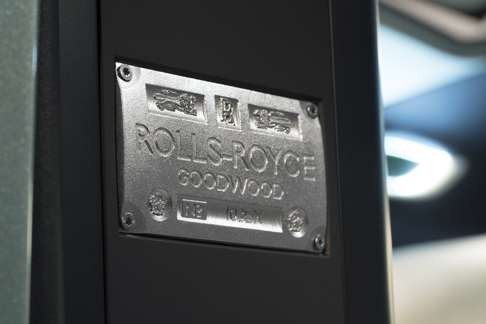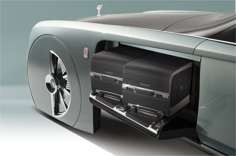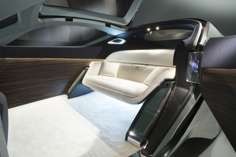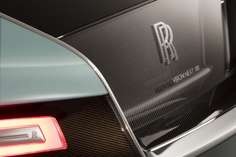
Still at the heart of luxury, and unashamedly so
Roll-Royce’s Vision Next 100, takes the Silver Lady’s dynamism to a new level

“In my entire career I have never had a brief quite so open, and I probably won’t again,” says Giles Taylor. “It’s really about being serious and credible, while also letting the ideas run wild.
“I can only hope that I’m around long enough to see some of those ideas come to fruition.”
Taylor is director of design for Rolls-Royce, the man who, since joining the BMW-owned historic British carmaker five years ago, has been key in reshaping its image from the slightly stuffy to the excitingly dynamic.
But, as production of the seventh-generation Phantom ends, the company’s latest vehicle — the 103EX, or Vision Next 100 — takes that dynamism to a new level.
The imposing, 5.9m long, 1.6m high car is, from the exterior, identifiably Rolls-Royce: the sweeping lines, the long bonnet, Pantheon grille and Spirit of Ecstasy hood ornament.
But much else is ground-breaking, indeed, there are hints of Lady Penelope’s futuristic Rolls-Royce from the Thunderbirds. It has a coach door and one-way, dark glass clamshell canopy, with a step emerging from the running board to allow easier egress.

Inside, the usual seating configuration is replaced by what looks to be a free-floating silk-upholstered sofa, the front wall of the cabin dominated by a transparent OLED screen.
New engine technology means much more space can be give over to a vast luggage compartment. Other advances include “Eleanor” — named after the model for the Spirit of Ecstasy — a virtual assistant and chauffeur, marrying the passenger’s schedule with the journey’s traffic environment.
If that last point is not a giveaway, and some are still now reaching for their chequebooks, it may prove disappointing to discover that the 103EX does not actually exist. Yet. Rather it is Rolls-Royce’s vision of tomorrow, the first in the marque’s history.

“The project was a chance to start with a clean sheet of paper and look at where we might be by, say, 2030 or 2040. The result is not a concept car — which is typically based on technology already around us — but a dream car. That said, we actually feel it’s a confident expression of what will happen, while being a little provocative.”
Certainly while predicting the future is a risky business (weren’t we all meant to be flying around in jet packs and holidaying on the moon by now?) many of the ideas in the 103EX run counter to prevailing notions of the car’s future.
This typically sees the car less as personal, protected, luxurious hub and more, since sustainability and urban build-up seems to demand it, as little more than a utilitarian, anonymous, shared and connected means of getting from A to B in increasingly congested cities.
We don’t want to be perceived as designing luxury for those fat cats who consume more for its own sake. The 103EX is a socially-responsible expression of luxury, attractive because it beguiles
But, combined, the Vision Next ideas add up to what Taylor suggests could be a new way to appreciate the kind of vehicle that risks becoming an increasingly anachronistic object.
“We’re in the world of luxury and should keep unashamedly in it,” says Taylor.
“But we don’t want to be perceived as designing luxury for those fat cats who consume more for its own sake. The 103EX is a socially-responsible expression of luxury, attractive because it beguiles.
“The car won’t be this static object but an expression of something more artful — and we feel the will be more people who will want that.
“Of course, there are flashy motor cars for flashy people. But the future will be more about focusing on that part of Rolls-Royce that is more discreet.
I’d love to feel that people will connect with Rolls-Royce at a kind of spiritual level. I think that’s the only way luxury can exist in the future.”

Taylor knows both sides. Prior to joining Rolls-Royce he designed at Citroen for six years and then at Jaguar for 14, where he oversaw the launch of the XJ.
“It’s about appealing to a world of people who connect with stand-out things, whether that’s a meal or a boat or a car,” he says.
It’s one reason why he expects the company, in future decades, to be able to offer the kind of bespoke service in which it is not just the trims that a customer can select, but, thanks to efficient use of tech the likes of 3D printing, basically the entire car. This is traditional coach building from a traditional coach builder. It’s back to the future.

Although Rolls-Royce does not venture details of its 103EX power plant, other than to say it would be emissions-free, the company does concede that it is unlikely to be its famed V12.
And then there is the notion that both cockpit and even steering wheel will be “superfluous”. Will any actual driving still be done in the future?
There is hope in the fact that Taylor for one certainly hopes so. “I don’t want a back-seat experience and I think as a company that we still believe in steering wheels and in driving,” he laughs. “Why? Well, speaking personally, because I think driving is cool. But it all goes back to pleasure of the wind in your hair - the thrill and sense of freedom that underpins why the car was invented in the first place.”